Experimental and Numerical Investigation into the Stability Behaviour of Cable-Stiffened Steel Columns
Abstract
1. Introduction
2. Experiment Description
3. Material Property Test
4. Column Compression Test
4.1. Test Scheme
4.2. Experimental Preparation
4.2.1. Geometrical Configurations
4.2.2. Initial Pretension
4.3. Experimental Results
4.3.1. Experimental Results of Stiffened Columns with
- (1)
- (2)
- (3)
- (4)
4.3.2. Experimental Results for Stiffened Columns with
- (1)
- (2)
4.3.3. Experimental Results for Stiffened Columns with
- (1)
- (2)
4.3.4. Experimental Results for Ordinary Compression Columns
5. Numerical and Experimental Results Comparison
5.1. Numerical Investigation
5.1.1. Cable-Stiffened Steel Columns
5.1.2. Ordinary Columns
6. Conclusions
- (1)
- The stability behaviours of the ordinary compression steel column were significantly enhanced by introducing prestressed cables; they could be improved by about three times if the initial pretension is appropriately designed.
- (2)
- The effect of eccentricity on the buckling behaviour of CSSCs differed from that seen for the ordinary columns. For the ordinary compression columns, the buckling load was decreased from 41.65 kN to 26.94 kN when the eccentricity was increased from 0 to 30 mm, but for the CSSCs the load decreased from 122.16 kN to 75.09 kN when the initial pretension was . In contrast, the buckling mode for the ordinary columns could not be changed by the variation of eccentricity, but that of the CSSCs could be affected by the eccentricity.
- (3)
- Initial pretension could affect the load-carrying capacities of CSSCs for both axial and eccentric loading cases; it has also been proven that the pretension level derived from the small deformation assumption does not correspond to the maximum buckling load.
Author Contributions
Funding
Institutional Review Board Statement
Informed Consent Statement
Data Availability Statement
Conflicts of Interest
References
- Thai, D.N.; Van Minh, P.; Hoang, C.P.; Duc, T.T.; Cam, N.N.T. Bending of Symmetric Sandwich FGM Beams with Shear Connectors. Math. Probl. Eng. 2021, 2021, 7596300. [Google Scholar] [CrossRef]
- Dung, N.T.; Van Minh, P.; Hung, H.M.; Tien, D.M. The Third-Order Shear Deformation Theory for Modeling the Static Bending and Dynamic Responses of Piezoelectric Bidirectional Functionally Graded Plates. Adv. Mater. Sci. Eng. 2021, 2021, 5520240. [Google Scholar] [CrossRef]
- Saitoh, M.; Tosiya, K. A study on structural behaviors of beam string structure. In Proceedings of the Summaries of Technical Papers of Annual Meeting Architectural Institute of Japan, Tokyo, Japan, 25 July 1985; pp. 280–284. [Google Scholar]
- Li, P.; Wadee, M.A.; Yu, J.; Christie, N.G.; Wu, M. Stability of prestressed stayed steel columns with a three branch crossarm system. J. Constr. Steel Res. 2016, 122, 274–291. [Google Scholar] [CrossRef]
- Kawaguchi, M.; Abe, M.; Tatemichi, I. Design, tests and realization of ‘suspen-dome’ system. J. Int. Assoc. Shell Spatial 1999, 40, 179–192. [Google Scholar]
- Wang, H.; Li, P.; Wang, J. Shape optimization and buckling analysis of novel two-way aluminum alloy latticed shells. J. Build. Eng. 2020, 36, 102100. [Google Scholar] [CrossRef]
- Osofero, A.I. Behaviour and Design of Prestressed Stayed Columns. Ph.D. Dissertation, Imperial College London, London, UK, 2012. [Google Scholar]
- Chu, K.H.; Berge, S.S. Analysis and design of crossarms with tension ties. J. Struct. Div. 1963, 1, 127–163. [Google Scholar] [CrossRef]
- Mauch, H.R.; Felton, L.P. Optimum Design of Columns Supported by Tension Ties. J. Struct. Div. 1967, 93, 201–220. [Google Scholar] [CrossRef]
- Hafez, H.H.; Temple, M.C.; Ellis, J.S. Pre-tensioning of single-crossarm stayed columns. J. Struct. Div. 1979, 105, 359–375. [Google Scholar] [CrossRef]
- Saito, D.; Wadee, M.A. Numerical studies of interactive buckling in prestressed steel stayed columns. Eng. Struct. 2009, 31, 432–443. [Google Scholar] [CrossRef]
- Yu, J.; Wadee, M.A. Mode interaction in triple-bay prestressed stayed columns. Int. J. Non Linear Mech. 2017, 88, 47–66. [Google Scholar] [CrossRef]
- Różyło, P.; Łukasik, D. Numerical analysis of the critical state of thin-walled structure with z-profile cross section. Adv. Sci. Technol. Res. J. 2017, 11, 194–200. [Google Scholar] [CrossRef]
- Kubiak, T.; Samborski, S.; Teter, A. Experimental investigation of failure process in compressed channel-section GFRP laminate columns assisted with the acoustic emission method. Compos. Struct. 2015, 133, 921–929. [Google Scholar] [CrossRef]
- Zhou, P.; Guo, Y.-L.; Pi, Y.-L. Numerical investigations of multiple cross-arm pre-tensioned cable stayed BRBs with pin-ended stays. J. Constr. Steel Res. 2018, 148, 206–232. [Google Scholar] [CrossRef]
- Zschernack, C.; Wadee, M.A.; Völlmecke, C. Nonlinear buckling of fibre-reinforced unit cells of lattice materials. Compos. Struct. 2016, 136, 217–228. [Google Scholar] [CrossRef]
- Chan, S.-L.; Shu, G.-P.; Lü, Z.-T. Stability analysis and parametric study of pre-stressed stayed columns. Eng. Struct. 2001, 24, 115–124. [Google Scholar] [CrossRef]
- Martins, J.P.; Shahbazian, A.; da Silva, L.S.; Rebelo, C.; Simões, R. Structural behaviour of prestressed stayed columns with single and double cross-arms using normal and high strength steel. Arch. Civ. Mech. Eng. 2016, 16, 618–633. [Google Scholar] [CrossRef]
- Wu, K.; Wadee, M.A.; Gardner, L. Prestressed stayed beam-columns: Sensitivity to prestressing levels, pre-cambering and imperfections. Eng. Struct. 2020, 226, 111344. [Google Scholar] [CrossRef]
- Li, P.; Wang, H. A novel strategy for the crossarm length optimization of PSSCs based on multi-dimensional global optimization algorithms. Eng. Struct. 2021, 238, 112238. [Google Scholar] [CrossRef]
- Wang, H.; Li, P.; Wu, M. Crossarm length optimization and post-buckling analysis of prestressed stayed steel columns. Thin-Walled Struct. 2019, 144, 106371. [Google Scholar] [CrossRef]
- Hyman, P.; Osofero, A.I. Behaviour of eccentrically loaded prestressed stayed columns with circular hollow sections. Adv. Struct. Eng. 2020, 23, 2813–2821. [Google Scholar] [CrossRef]
- de Araujo, R.; de Andrade, S.; Vellasco, P.; da Silva, J.; de Lima, L. Experimental and numerical assessment of stayed steel columns. J. Constr. Steel Res. 2008, 64, 1020–1029. [Google Scholar] [CrossRef]
- Osofero, A.I.; Wadee, M.A.; Gardner, L. Experimental study of critical and post-buckling behaviour of prestressed stayed columns. J. Constr. Steel Res. 2012, 79, 226–241. [Google Scholar] [CrossRef]
- Serra, M.; Shahbazian, A.; da Silva, L.S.; Marques, L.; Rebelo, C.; Vellasco, P.C.G.D.S. A full scale experimental study of prestressed stayed columns. Eng. Struct. 2015, 100, 490–510. [Google Scholar] [CrossRef]
- Lv, G.; Li, P.; Zhang, C.; Sun, X.; Chen, E. Experimental investigation into the buckling behaviour of cable-stiffened steel columns. J. Constr. Steel Res. 2021, 183, 106753. [Google Scholar] [CrossRef]
- GB/T 228.1–2010; Metallic Materials—Tensile Testing—Part 1: Method of Test at Room Temperature. Chinese Standardization Administration: Beijing, China, 2010.
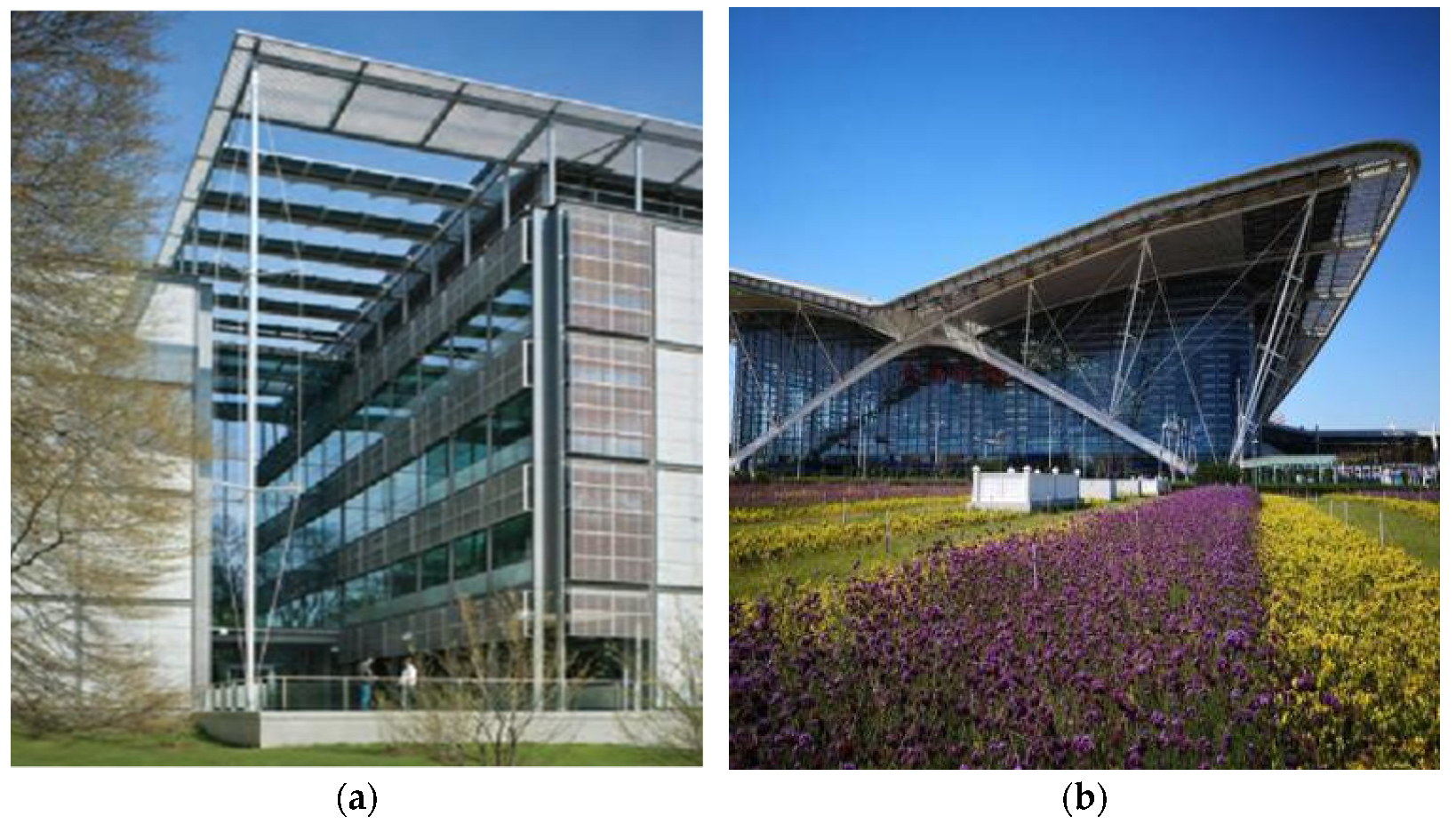
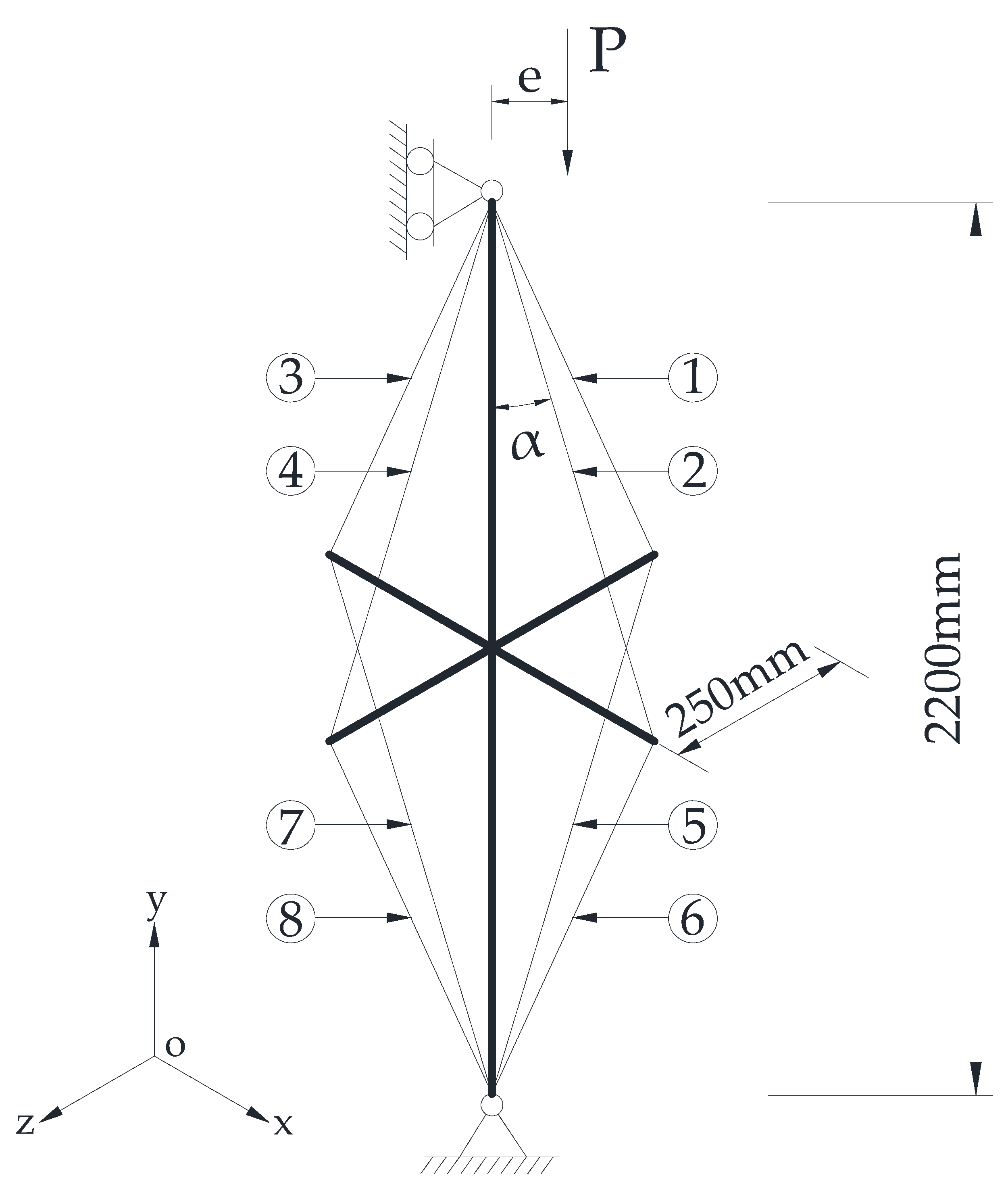

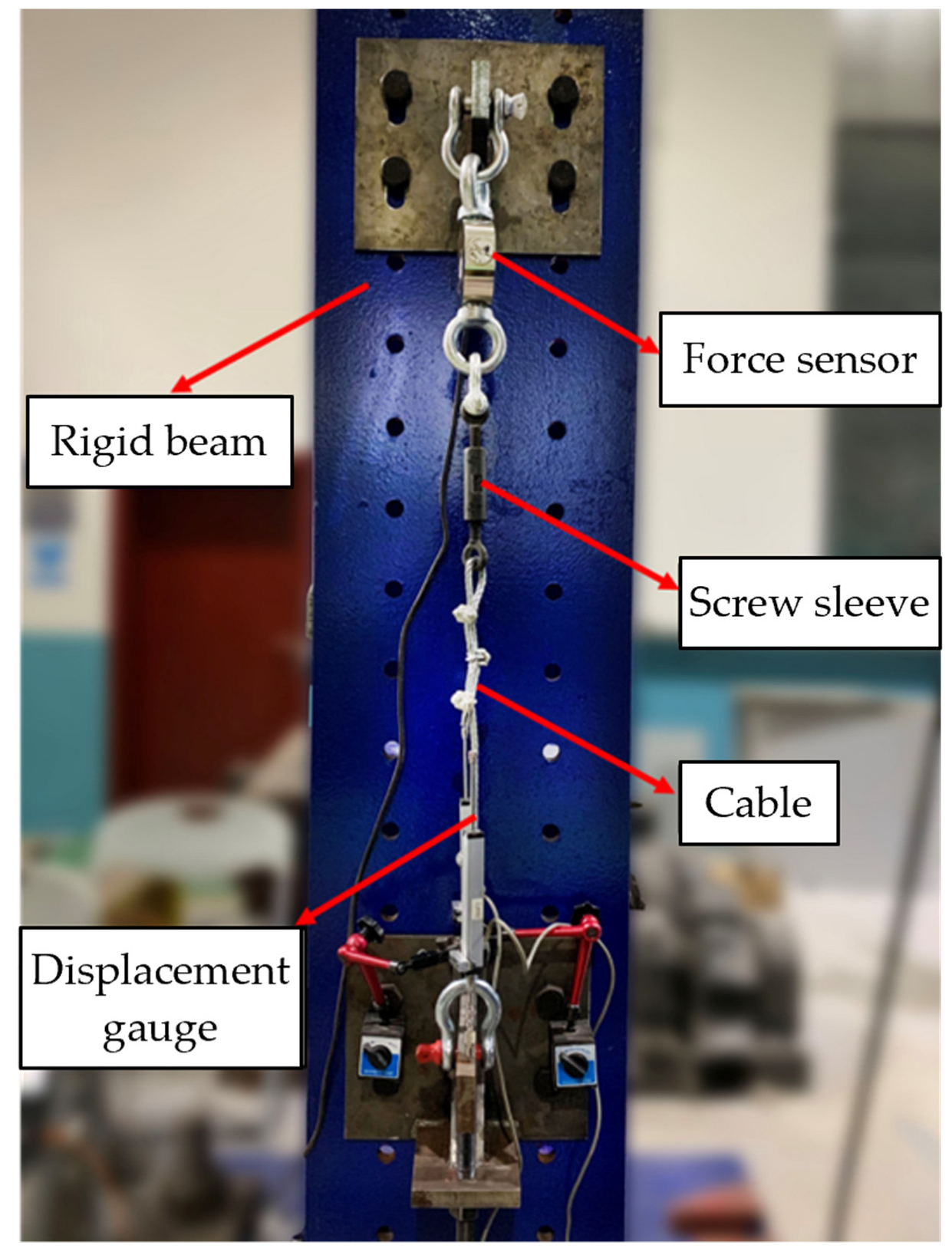
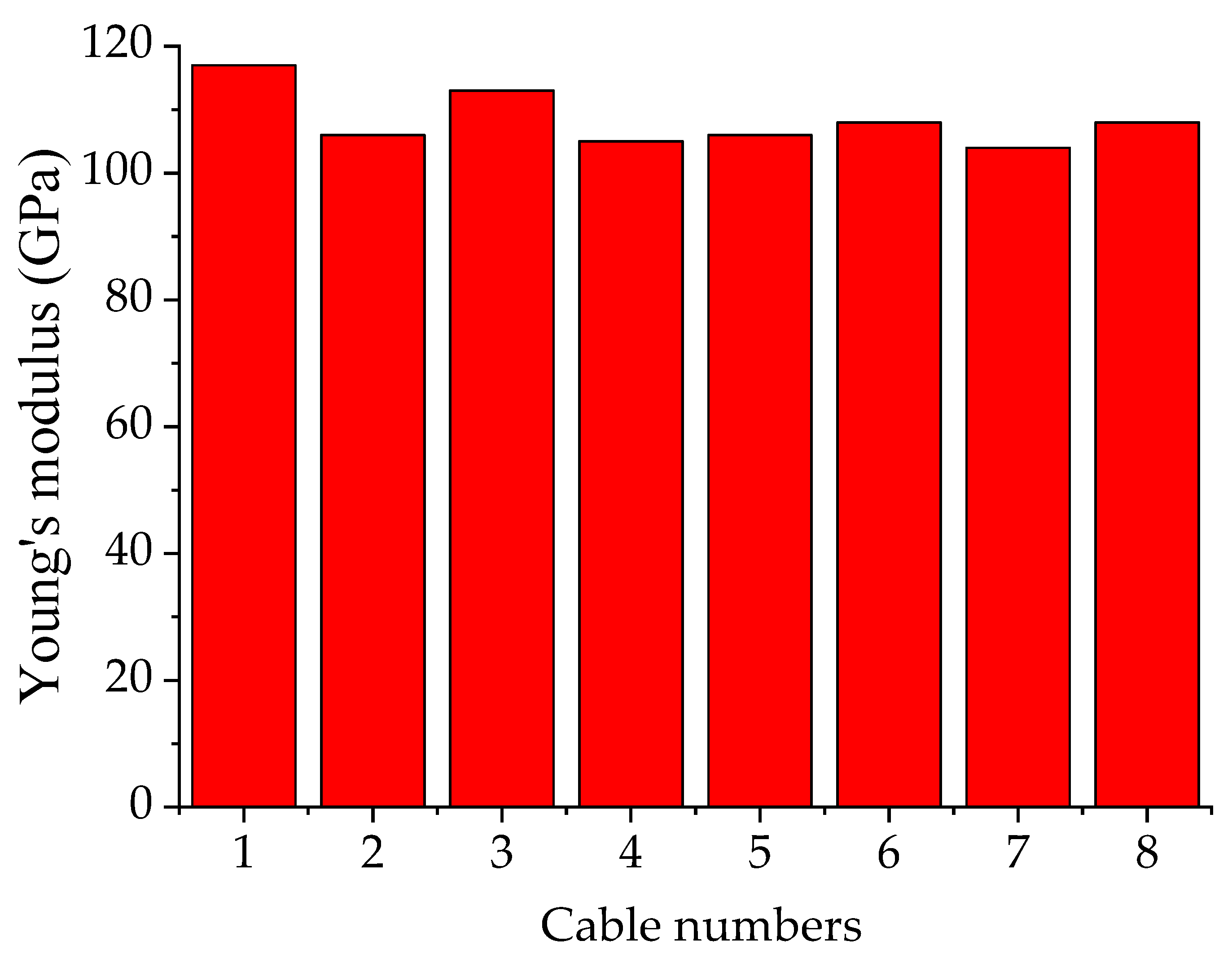
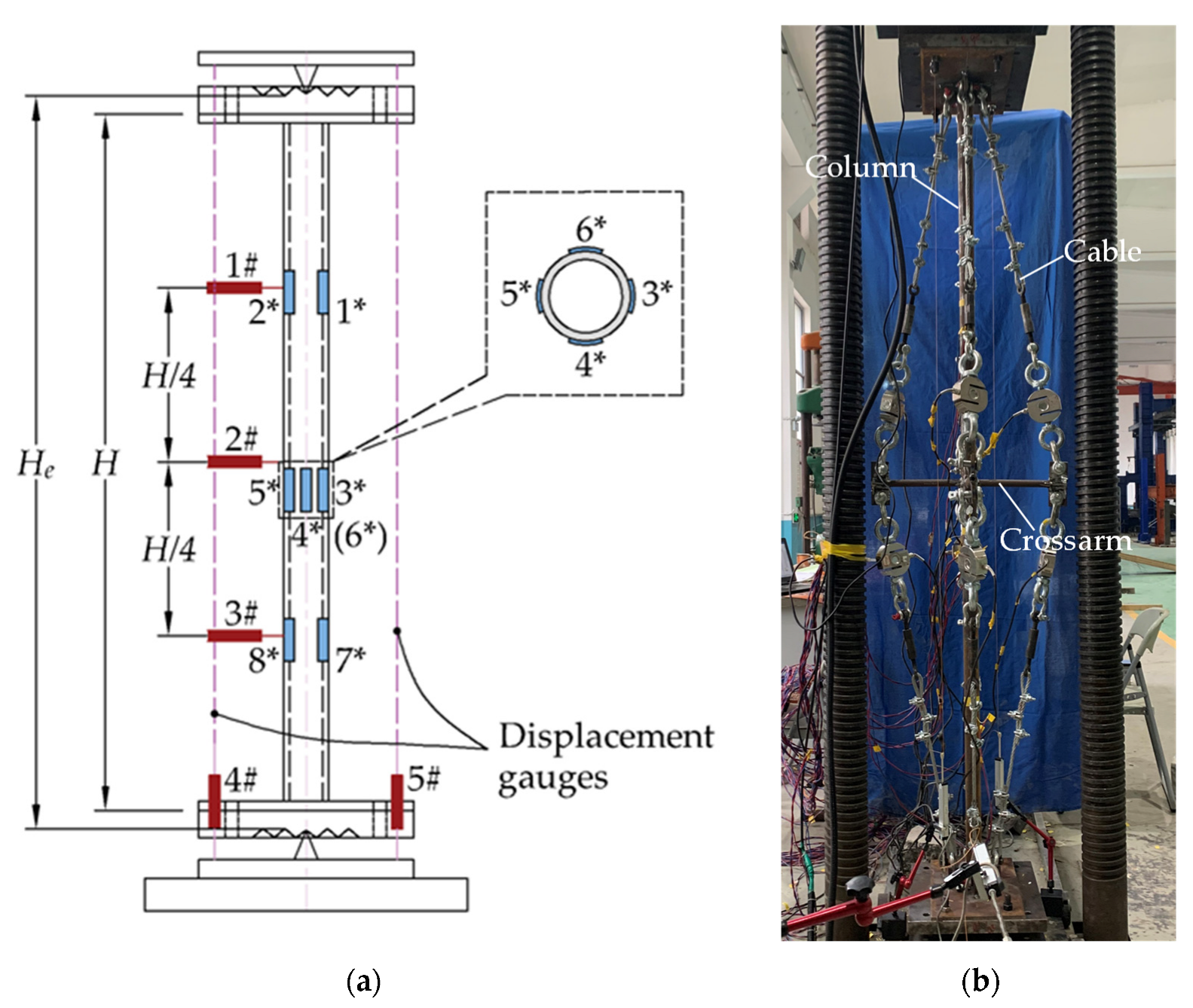
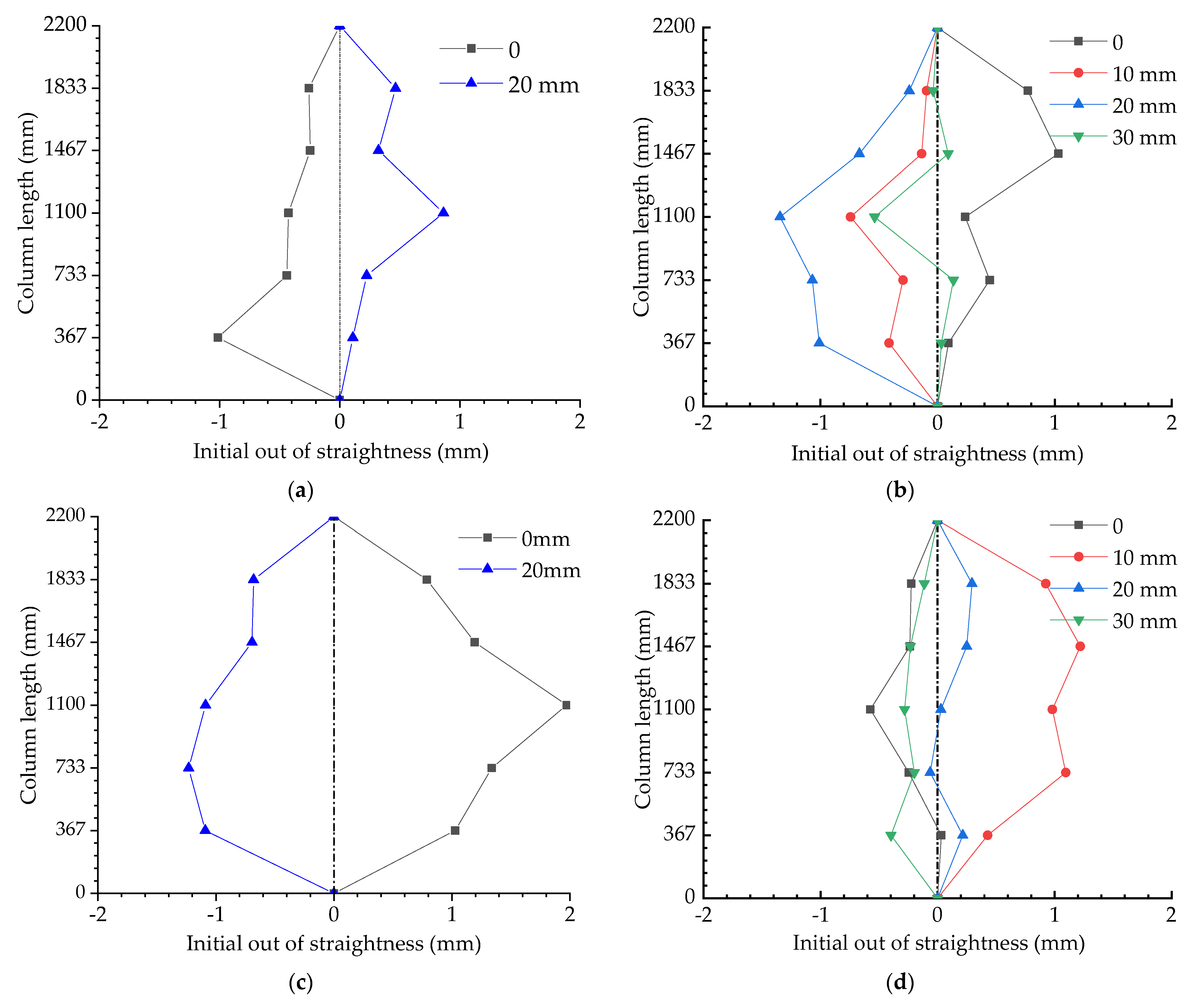
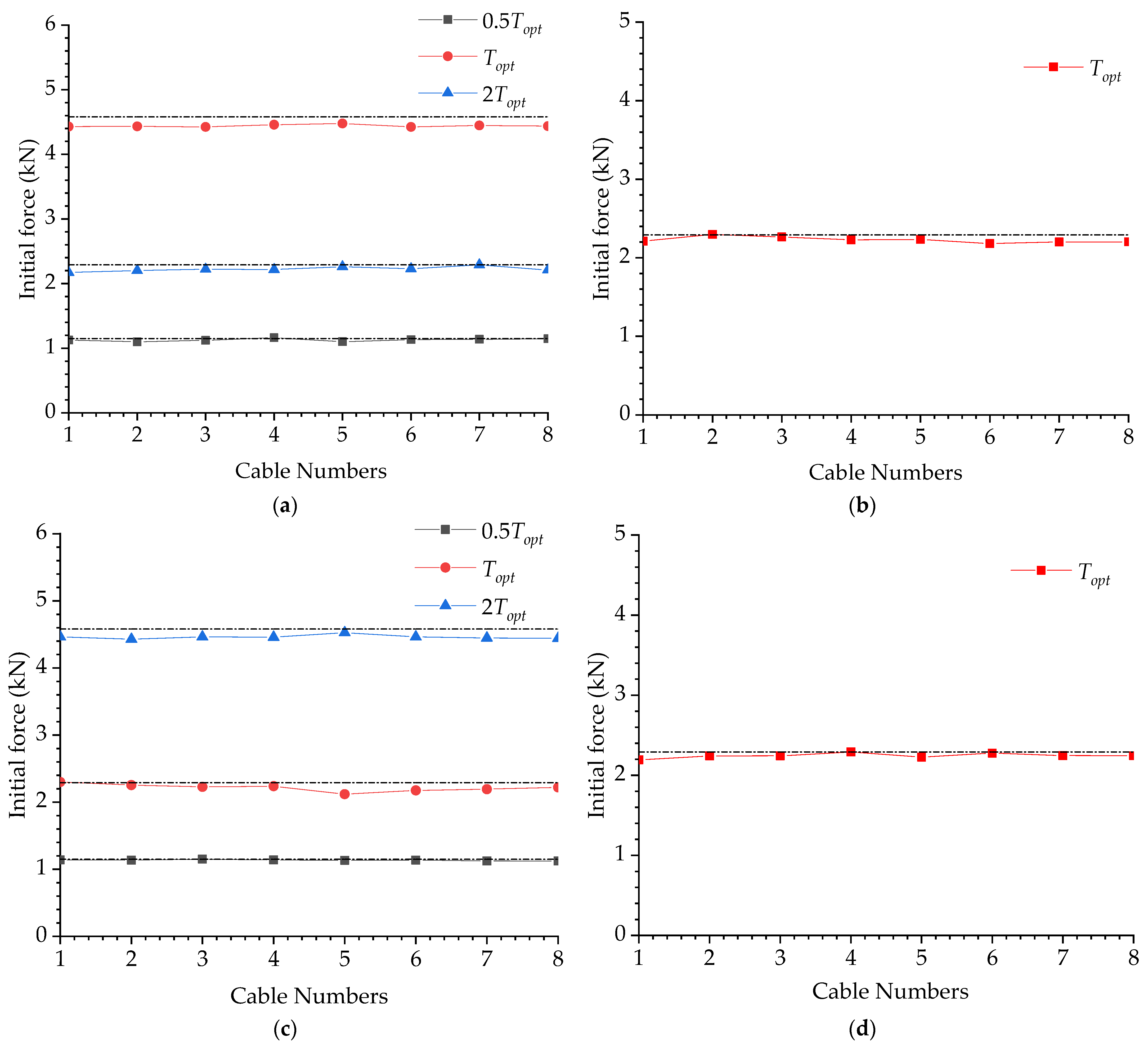
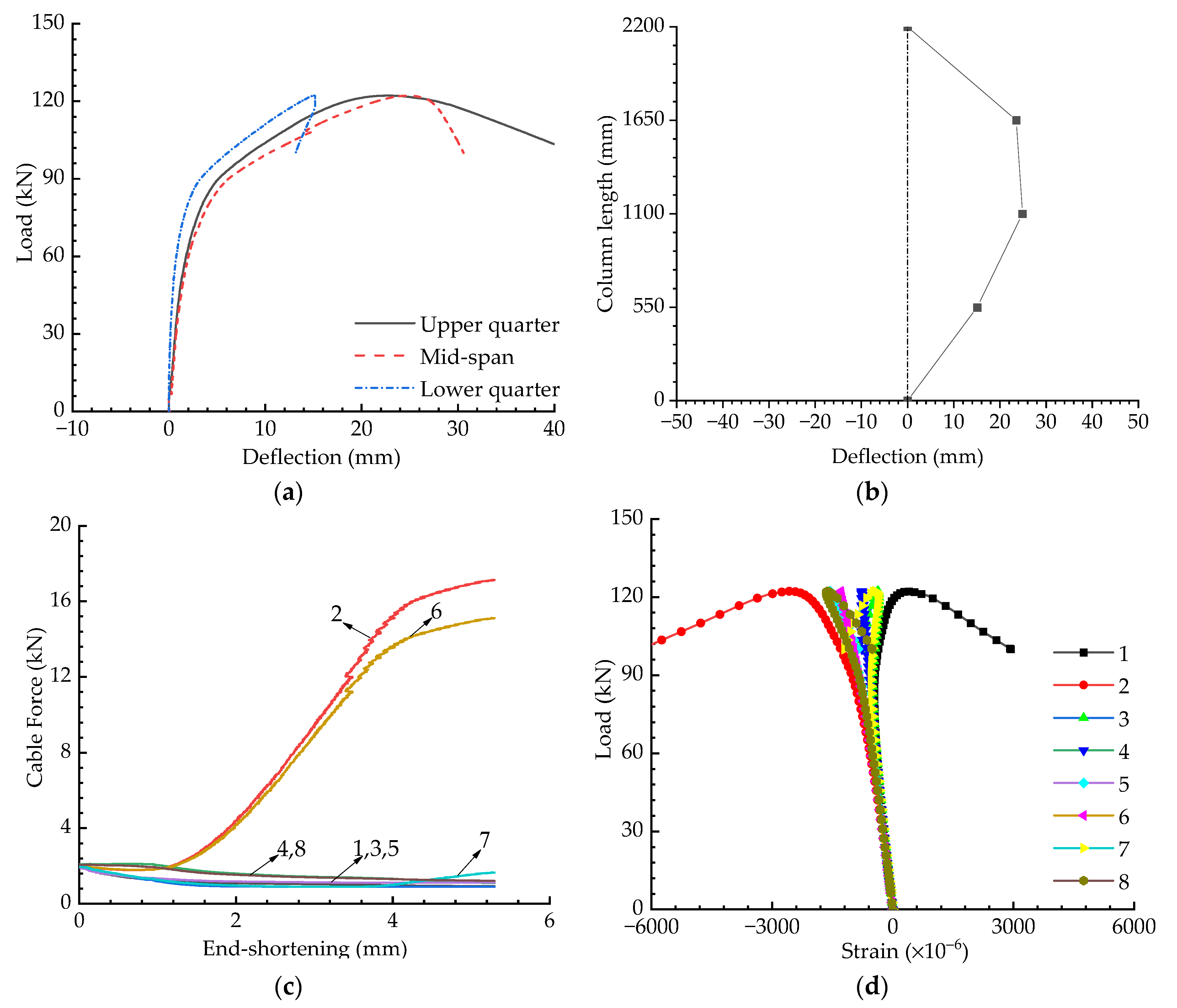
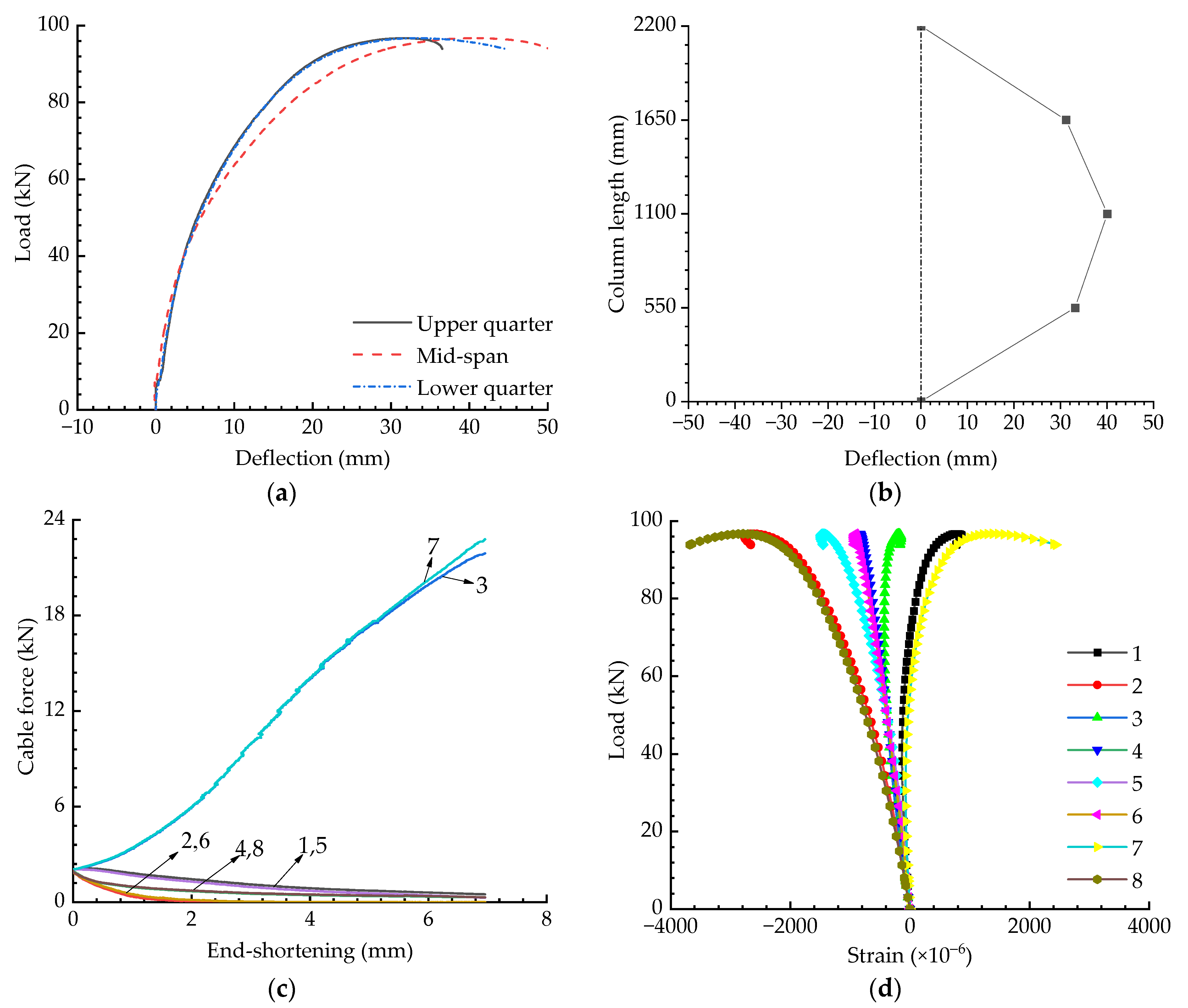

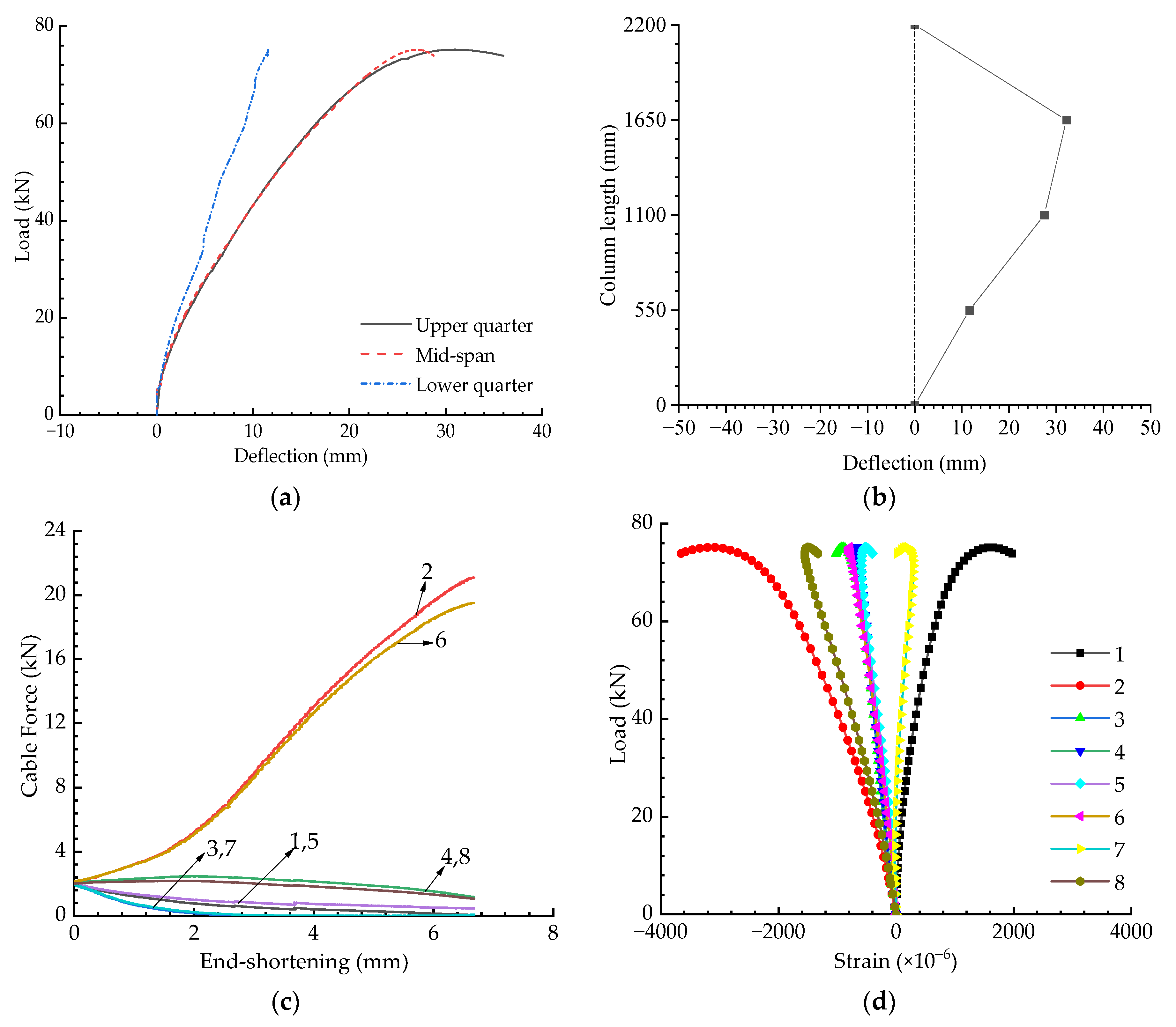
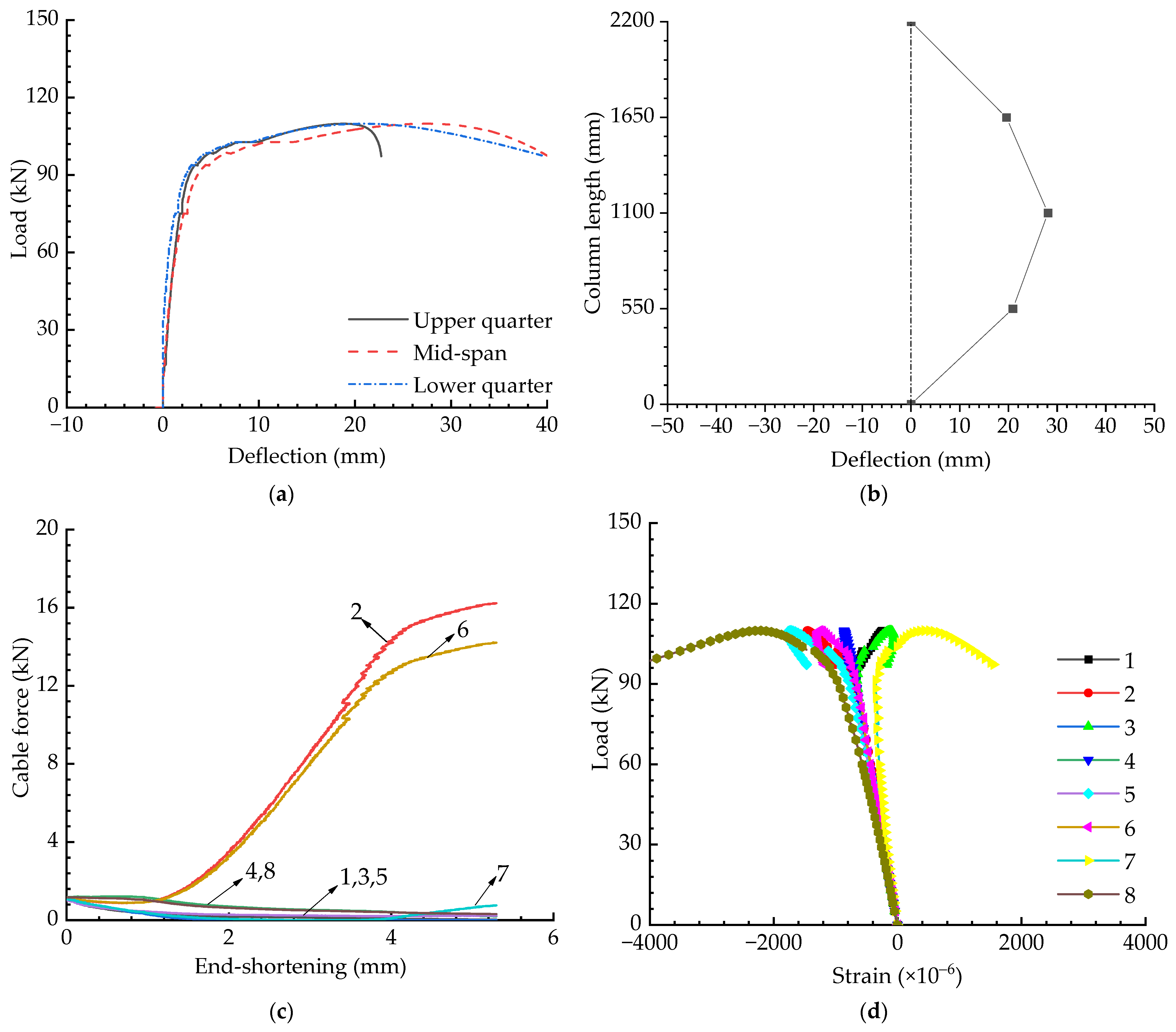
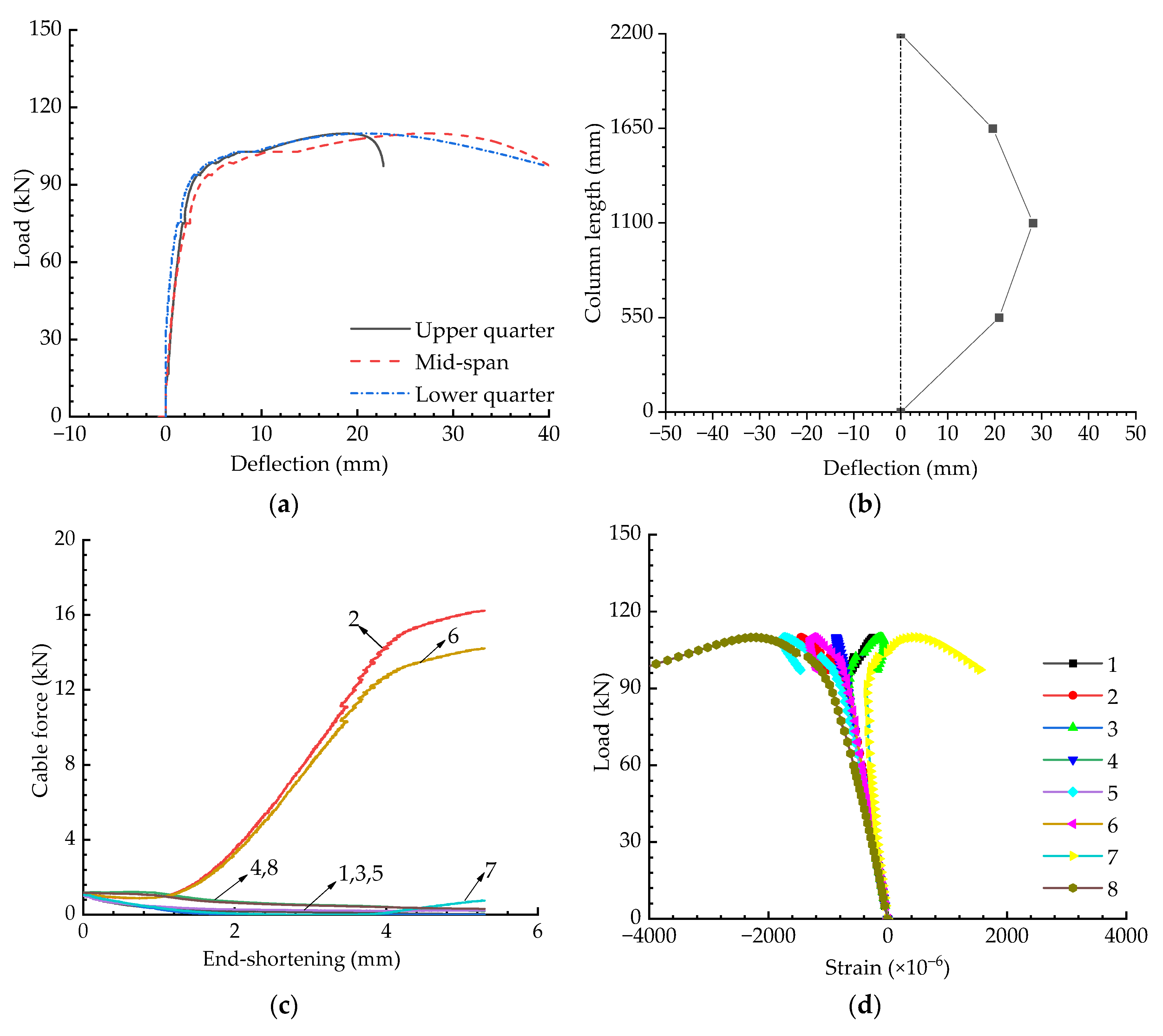

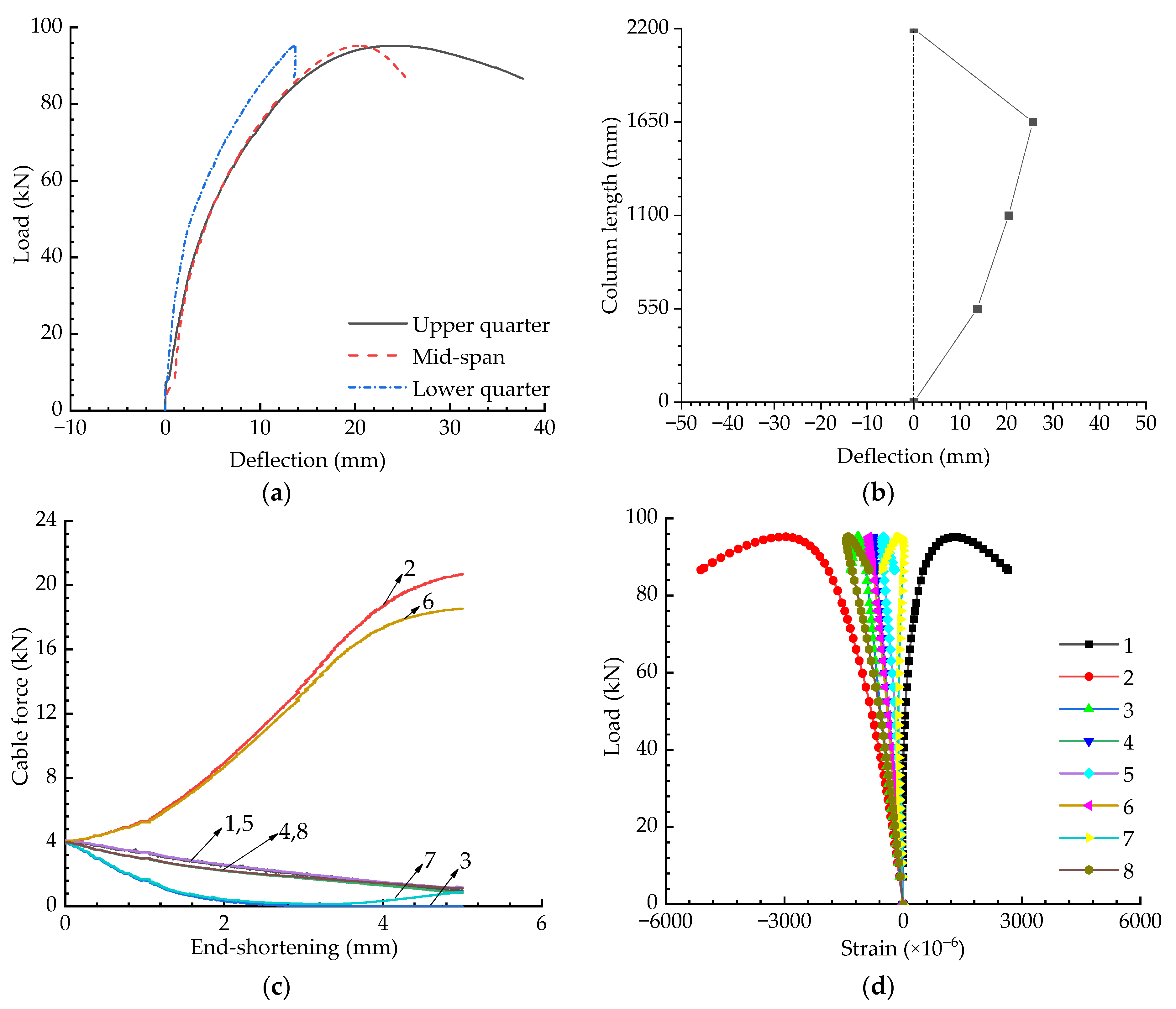
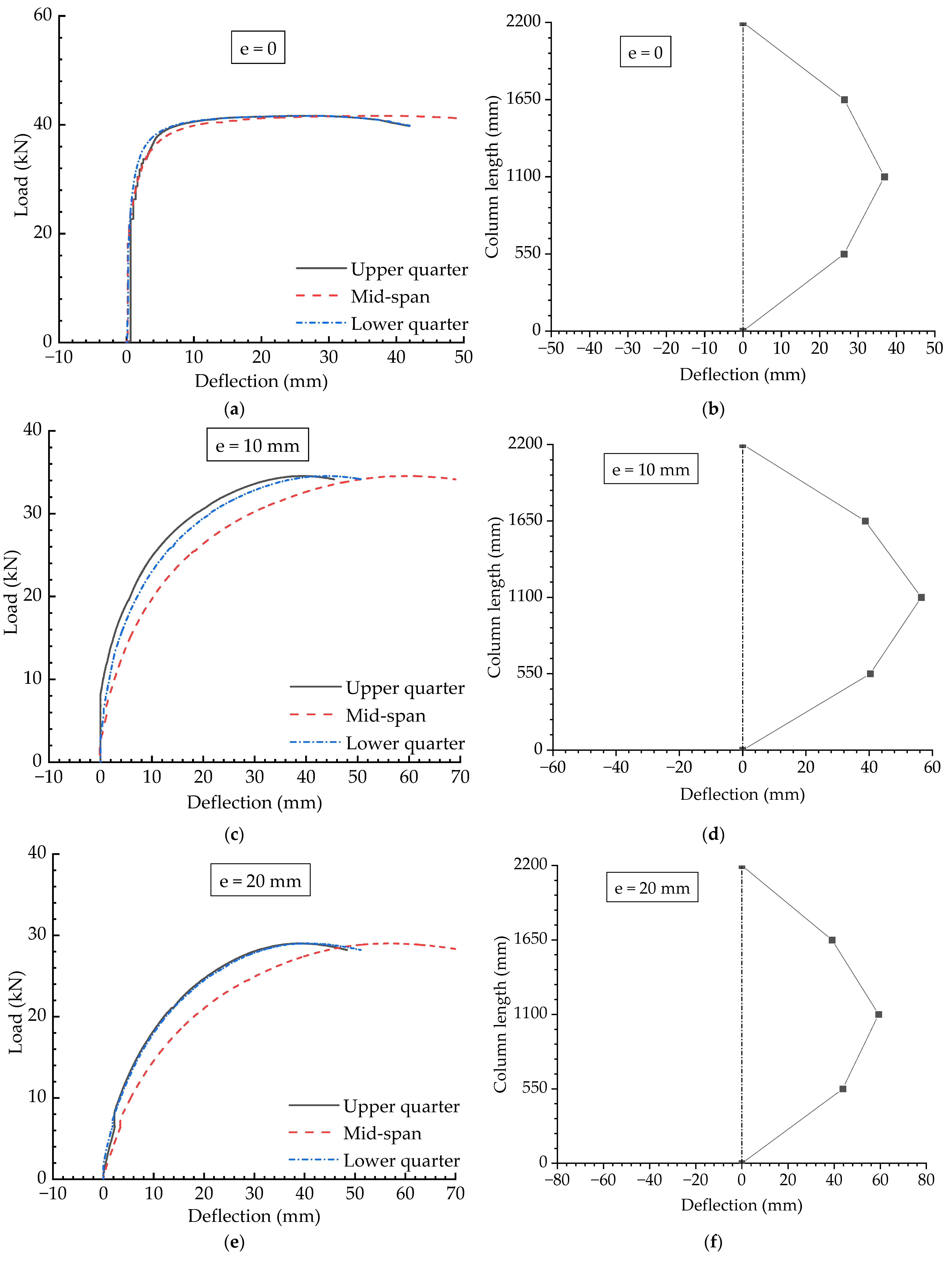

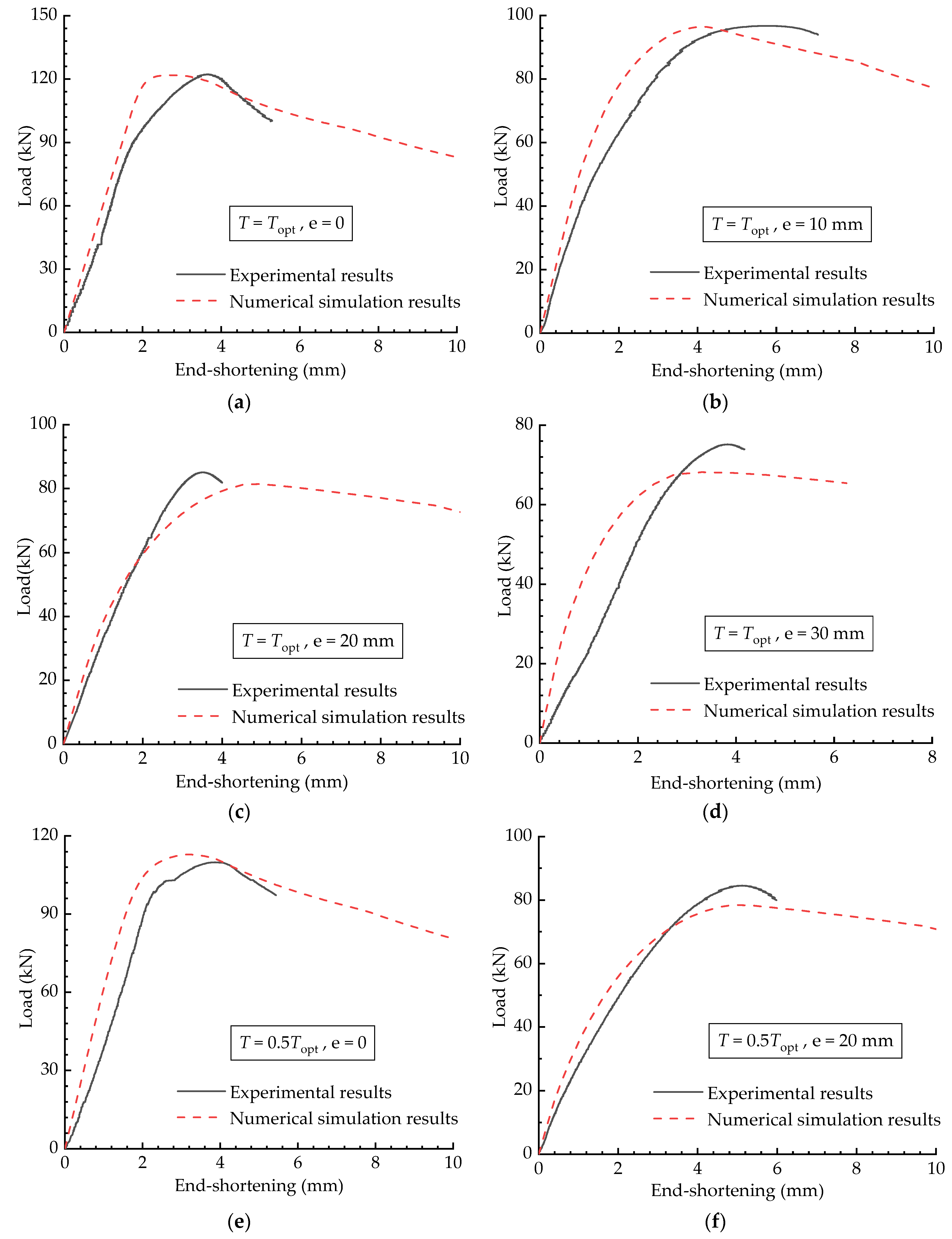
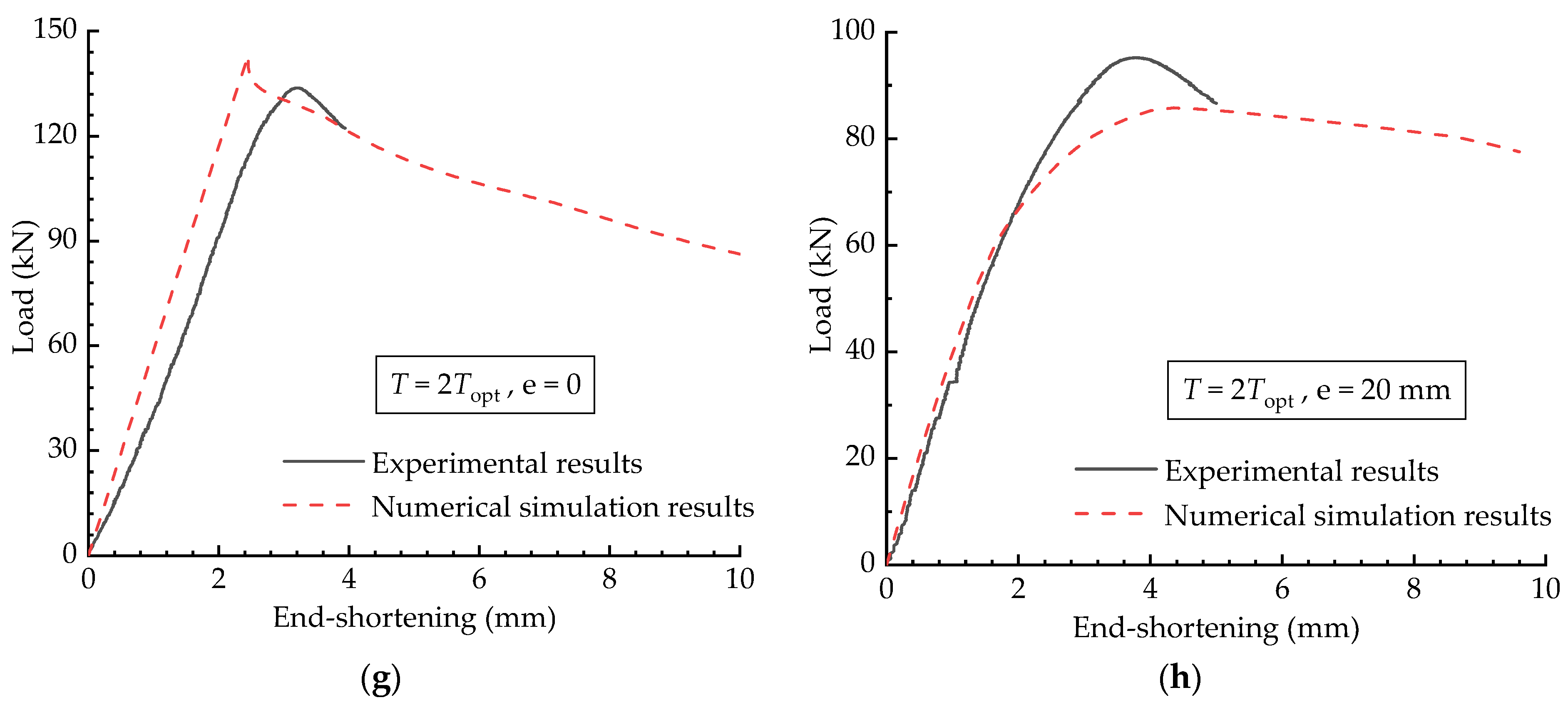
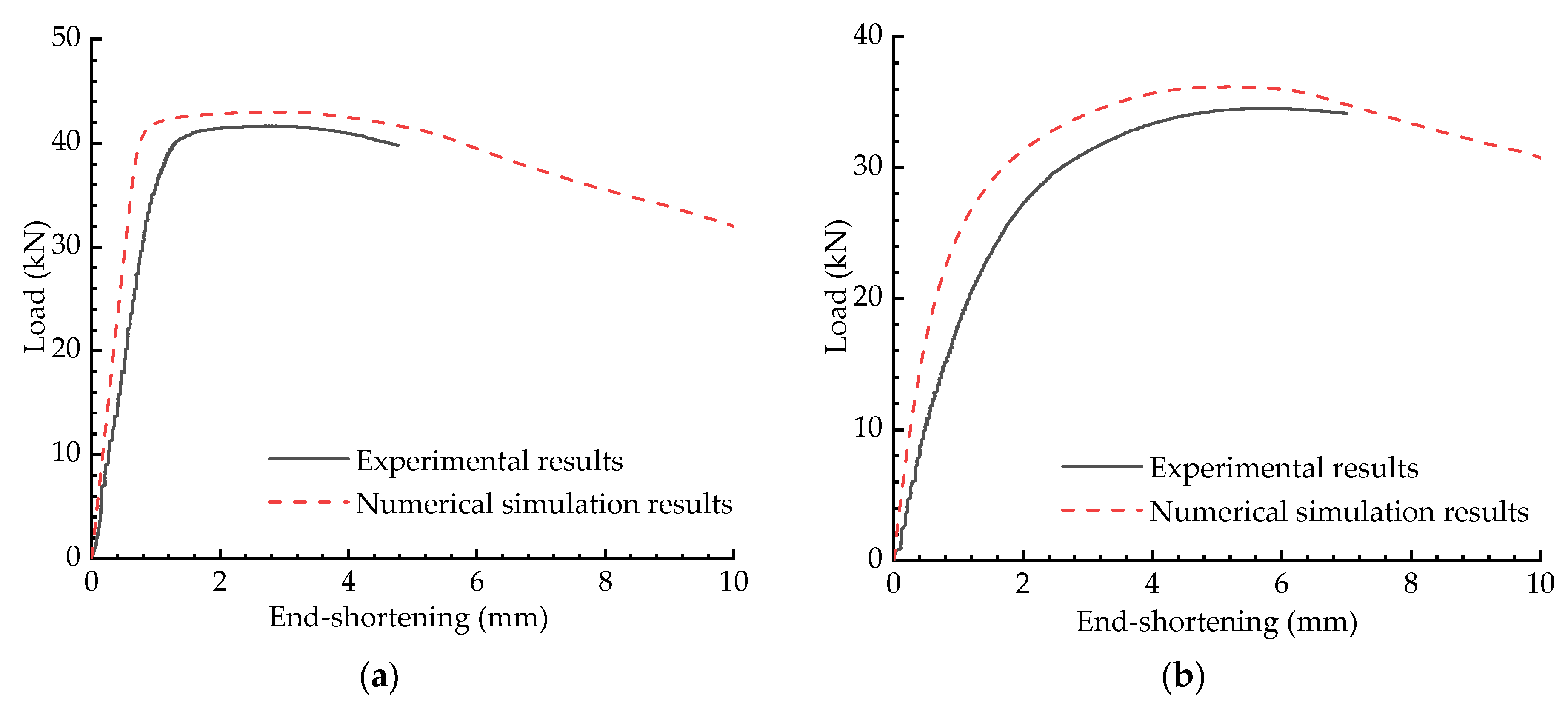
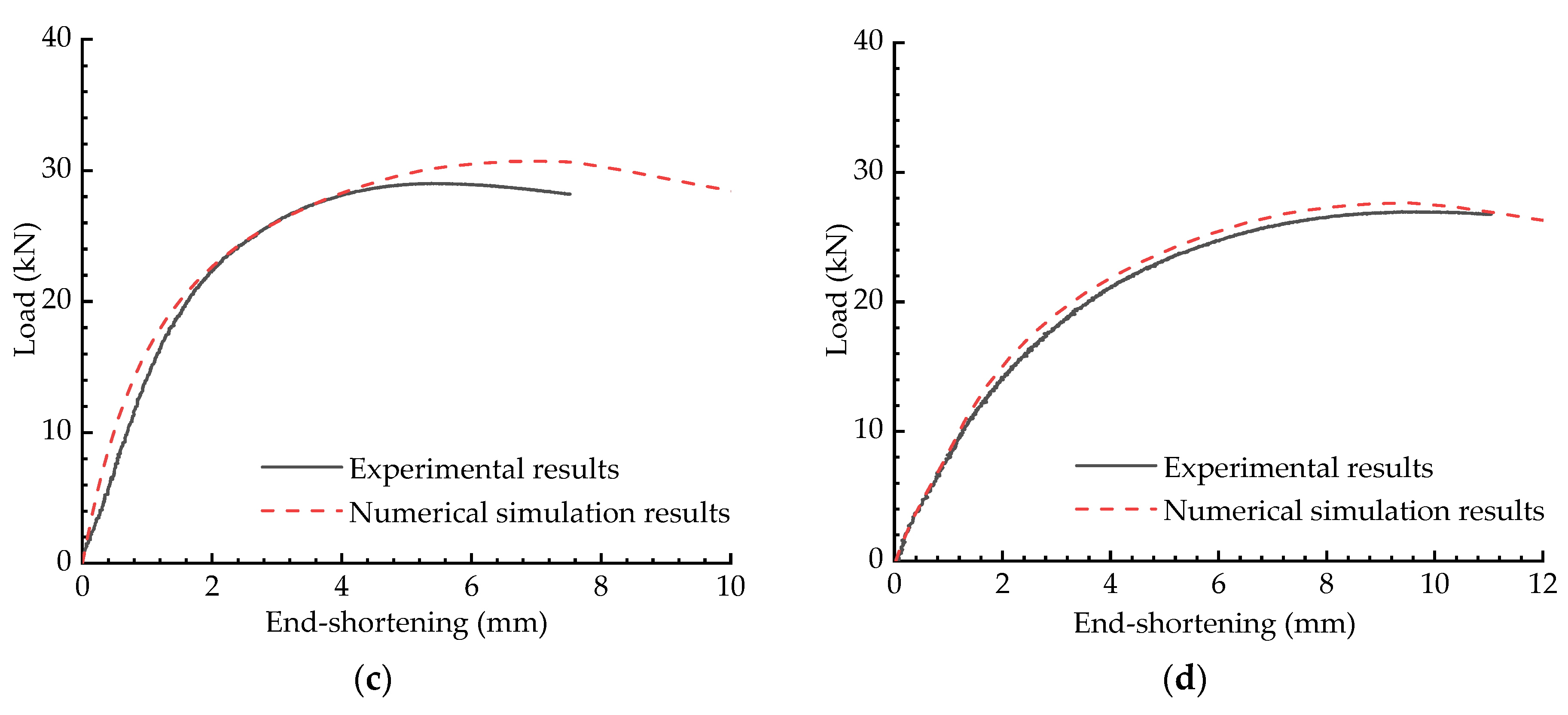
| Column Types | Initial Pretensions | Eccentricities (mm) | |||
|---|---|---|---|---|---|
| 0 | 10 | 20 | 30 | ||
| Cable-stiffened columns | √ | —— | √ | —— | |
| √ | √ | √ | √ | ||
| √ | —— | √ | —— | ||
| Ordinary columns | No cables | √ | √ | √ | √ |
| Specimen Types | Specimen No. | Young’s Modulus (MPa) | Buckling Strength (MPa) | Ultimate Tensile Strength (MPa) |
|---|---|---|---|---|
| Main column | 1 | 213 | 415 | 545 |
| 2 | 209 | 410 | 550 | |
| 3 | 203 | 420 | 540 | |
| Average | 208 | 415 | 545 | |
| Crossarm | 1 | 173 | 285 | 405 |
| 2 | 188 | 290 | 405 | |
| 3 | 181 | 285 | 410 | |
| Average | 181 | 287 | 407 |
| Pretensions | Types | Eccentricities | |||||||
|---|---|---|---|---|---|---|---|---|---|
| 0 mm | 10 mm | 20 mm | 30 mm | ||||||
| Column | Crossarm | Column | Crossarm | Column | Crossarm | Column | Crossarm | ||
| Outer diameters | 42.31 | 19.96 | —— | —— | 42.31 | 19.87 | —— | —— | |
| Thicknesses | 5.59 | 4.00 | —— | —— | 5.52 | 3.93 | —— | —— | |
| Lengths | 2199 | 249 | —— | —— | 2198 | 250 | —— | —— | |
| Outer diameters | 42.22 | 19.81 | 42.39 | 19.86 | 42.34 | 19.99 | 42.24 | 19.89 | |
| Thicknesses | 5.50 | 3.95 | 5.46 | 3.91 | 5.68 | 3.96 | 5.54 | 3.88 | |
| Lengths | 2199 | 250 | 2198 | 251 | 2200 | 250 | 2199 | 250 | |
| Outer diameters | 42.34 | 20.02 | —— | —— | 42.26 | 19.91 | —— | —— | |
| Thicknesses | 5.57 | 3.92 | —— | —— | 5.43 | 3.89 | —— | —— | |
| Lengths | 2199 | 248 | —— | —— | 2200 | 249 | —— | —— | |
| Types | Eccentricities | |||
|---|---|---|---|---|
| 0 mm | 10 mm | 20 mm | 30 mm | |
| Outer diameters | 42.23 | 42.45 | 42.22 | 42.36 |
| Thicknesses | 5.64 | 5.57 | 5.50 | 5.55 |
| Lengths | 2200 | 2200 | 2198 | 2198 |
| 0.5 Topt | Topt | 2 Topt |
|---|---|---|
| 1.15 kN | 2.29 kN | 4.58 kN |
Publisher’s Note: MDPI stays neutral with regard to jurisdictional claims in published maps and institutional affiliations. |
© 2022 by the authors. Licensee MDPI, Basel, Switzerland. This article is an open access article distributed under the terms and conditions of the Creative Commons Attribution (CC BY) license (https://creativecommons.org/licenses/by/4.0/).
Share and Cite
Li, P.; Zhao, X.; Qiu, J.; Qian, J.; Zhu, Z.; Zhang, Z.; Meng, L. Experimental and Numerical Investigation into the Stability Behaviour of Cable-Stiffened Steel Columns. Materials 2022, 15, 8813. https://doi.org/10.3390/ma15248813
Li P, Zhao X, Qiu J, Qian J, Zhu Z, Zhang Z, Meng L. Experimental and Numerical Investigation into the Stability Behaviour of Cable-Stiffened Steel Columns. Materials. 2022; 15(24):8813. https://doi.org/10.3390/ma15248813
Chicago/Turabian StyleLi, Pengcheng, Xuxiang Zhao, Jianyue Qiu, Jianghua Qian, Zhao Zhu, Zhigang Zhang, and Lei Meng. 2022. "Experimental and Numerical Investigation into the Stability Behaviour of Cable-Stiffened Steel Columns" Materials 15, no. 24: 8813. https://doi.org/10.3390/ma15248813
APA StyleLi, P., Zhao, X., Qiu, J., Qian, J., Zhu, Z., Zhang, Z., & Meng, L. (2022). Experimental and Numerical Investigation into the Stability Behaviour of Cable-Stiffened Steel Columns. Materials, 15(24), 8813. https://doi.org/10.3390/ma15248813








